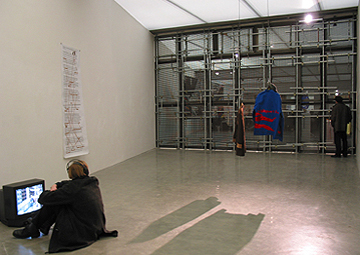Facade as a Status Difference: SITEX and RFID
in: Violence is at the Margins of all Things - Subject Relations, Political Militancy and Artistic Procedures, catalogue, (eds) Alice Creischer, Andreas Siekmann
Generali Foundation, Vienna
 |
||
| backstage | ||
We interpret the facade as an architectural divide which creates or maintains a difference in status. It differentiates between front and behind. Status difference as the difference between the states of inside and outside can make reference to various categories such as climate, light, acoustics, accessibility, security, privacy, power of disposal or applicable rules and regulations. The respective separations are created through various parts and layers of the facade, such as masonry heat insulation, vapor barrier, insulating panes, safety glass, door locks, railings or floor covering. We define facade here as the entirety of separating means between different spatial states.
The facade is a targeted conditionally permeable system allowing access on a selective basis. For example only desired gazes, appropriate lighting, fresh air, privileged persons and visitors at certain times, or at a certain admission fee.
The separating elements of the facade do not, however, consist of a wall of 20 to 50 centimeters. Especially when transparency and a smooth transition between outside and inside is the aim, the original functions of the facade are distributed across different constructional and technical elements: the climatic separation is performed by insulating panes and an air curtain at the entrance, protection against the sun by blinds, communication by advertising boards. Security is guaranteed by video cameras, theft protection and card reader systems and supplemented by security services ready to work. The facade turns into a zone and its functions may possibly spread across entire spatial sequences determined in differently powerful ways.
With regard to accessibility, technical systems are increasingly being developed for immaterial demarcation. If required, they make the invisible borders passable and deny access to the non-privileged. There are still physical borders guaranteeing spatial regulation and producing concrete exclusions. New, invisible instruments of control, on the other hand, perfect the illusion of there being no barriers, while at the same time enabling detailed surveillance and localization of persons and objects in the space. They allow the facades’ functions of exclusion and control to be increasingly distributed in public space and additional private spaces.
SITEX
The SITEX Sicherheitsanlagen GmbH is part of the British ORBIS Property Protection and market leader in the area of securing empty real estate in Germany. The core business of the firm is the SITEX security system, rentable steel elements serving to seal window and door openings in empty buildings to protect them from burglary, vandalism and squatting.
In addition, an insurance package is offered (together with the insurance group Generali Lloyd). Security is provided against damages caused by fire, explosion, willful damage and burglary as well as costs arising from removal work, fire extinguishing and police operations in case the building is cleared.
RFID
Radio Frequency Identification (RFID) denotes compactness identification via radio transmission. RFID systems consist of a read-write station and transponders. The transponders can be situated beneath tags on articles and on chip cards of company employees. They offer the possibility to store data.
Possible applications of RFID lie in logistics and stock-keeping as well as in the areas of personal identification, access controls and theft protection.